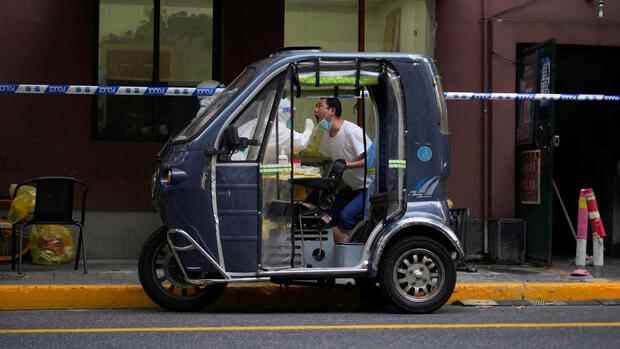Beijing The corona lockdowns in April and May massively damaged the Chinese economy. The second largest economy in the world grew by just 0.4 percent in the second quarter compared to the same period last year. That is significantly less than experts expected and the lowest value since the sharp slump in early 2020 after the first outbreak of the corona pandemic. Compared to the previous quarter, the economy shrank by 2.6 percent.
The data, released by the National Statistics Office on Friday, also suggests that the economy recovered in June. But the agency concedes that the basis for a sustained economic recovery is “unstable”. The downward pressure on the economy increased significantly in the second quarter. And further strains loomed from rising risks of stagflation in the global economy, monetary tightening in major economies and the impact of domestic virus outbreaks.
In addition to the growth figures, the statistical office also published June data on unemployment, retail trade, industrial production, investments and house prices, among other things. The retail sector recovered slightly in June after the sharp slump in May and April and grew by 3.1 percent. Industrial production increased by 3.9 percent. However, experts assume that this is largely a matter of catch-up effects.
The unemployment rate fell to 5.5 percent from 5.9 percent in May. However, the rate of unemployed youth and young adults aged 16 to 24 rose to a record 19.3 percent. The latter is increasingly worrying the state leadership. There is also no relaxation on the real estate market. House prices fell 0.1 percent from the previous month, indicating continued weak demand.
Top jobs of the day
Find the best jobs now and
be notified by email.
Given these risks, calls for a larger stimulus package are likely to become even louder. In mid-May, the State Council, led by China’s Premier Li Keqiang, passed a package of 33 economic stimulus measures to support the economy. They include, among other things, investments in infrastructure, easier lending, tax cuts and incentives to buy cars and household appliances, for example.
Premier Li sees ‘many uncertainties’
At an economic symposium on Wednesday, Li praised the “rapid and decisive measures without relying on massive stimulus”. However, the recovery is not yet fully complete and “many uncertainties remain”.
>> Read also: China’s economic slump forces the state to ‘unconventional measures’
In particular, the risk of a new corona wave “should not be underestimated,” warns Lu Ting, China chief economist at the Japanese investment bank Nomura. Renewed lockdowns and other restrictive measures could hamper production and logistics. He still sees “significant growth risks” in the second half of the year.
The new, highly contagious BA.5 variant is currently spreading in China and is causing renewed corona restrictions in economic centers such as Shanghai, Guangzhou and Xi’an. Despite the negative economic side effects, China’s government is unwavering in its strict zero-Covid policy. This means that even in the case of individual corona cases, entire buildings or even districts are hermetically sealed off. President Xi Jinping recently reiterated his willingness to sacrifice some near-term growth to contain the country’s pandemic.
The International Monetary Fund on Wednesday urged China to change its draconian zero-Covid strategy.
(Photo: Bloomberg)
Unlike after the first pandemic-related economic slump in early 2020, exports are unlikely to help China’s economy recover quickly this time, experts believe. The fall in demand in major economies is likely to be a “strong headwind” for China’s export economy in the coming quarters, according to Lu.
Experts doubt that the measures announced so far are sufficient to stabilize the economy, let alone achieve the announced target of 5.5 percent growth. According to media reports, the government plans to massively increase infrastructure investments. According to Bloomberg news agency, government funds could provide $1.1 trillion in support.
IMF calls for departure from strict zero-Covid strategy
The International Monetary Fund on Wednesday urged China to expand fiscal support in the form of remittances and alter its draconian zero-Covid strategy to counter a slowdown in growth in the world’s second-largest economy. The IMF also encourages China to accelerate the stalled vaccination campaign, particularly targeting the undervaccinated elderly population.
So far, the state leadership has avoided adopting a huge stimulus package such as that after the 2008 financial crisis. At that time, she fought the slump in exports with what was then the largest stimulus in the world of 587 billion dollars. China then recovered quickly from the crisis, but is still suffering from the side effects to this day: economic growth depends heavily on government investment.
Actually, the government around Xi Jinping wanted to get away from this “fictional growth” and develop domestic consumption to support the economy. However, the precarious situation of the Chinese economy as a result of the repeated lockdowns with no foreseeable end and the cooling of the global economy have destroyed this plan, at least for the time being.
More: Stock crash, growth slump, lockdown madness – the China crash.
